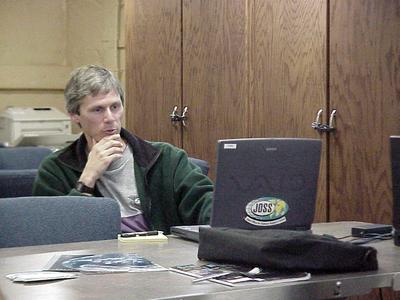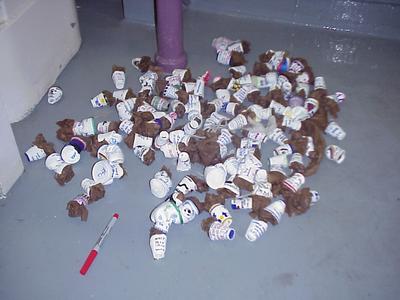13 August, 2002
You have probably noticed Steve Roberts's name in my journals. That's for
two reasons. The first is that he was one of two people who worked on my
computer for several hours when I had so many problems with it. He also
helps when I have problems with computer compatibility between my computer
and those on the ship. The other is that he has taken many of the pictures
that you see on my page of the TEA website. Fortunately for me Steve didn't
bring a camera on board, and he often borrows my digital camera. When he's
not helping me or taking pictures he spends all of his time working with the
JOSS website. Steve is a software engineer for the Joint Office for Science
Support (JOSS), a division of the University Corporation for Atmospheric
Research (UCAR), a non-profit, private corporation based in Boulder,
Colorado.
Steve's job is to keep up to date records of all the ship's sensor data
(which is also stored by the U. S. Coast Guard) as well as the data
generated by the science service team and by the scientists themselves. The
ship's sensor data includes information such as the ship's position, speed
and heading, all atmospheric data (weather information) and water conditions
such as temperature and salinity. Steve catalogs all the data to be
archived (saved for the future) on the JOSS website and to be made available
on a daily basis to the scientists on board and back on land. My journals
and photos are also on the JOSS website as are Lee Cooper's operational
reports. Lee's reports include all the information for each station such as
the sampling that was done and when it was done, ice conditions, any
problems that arose, etc. The site serves an extremely useful purpose for
the scientists. It assists them in documenting and sharing their data in
real time (as it is gathered) or close to it.
This is not the first time Steve has been on the Healy. From April 27 until
May 4, he was on board as the Healy traveled from its home base in Seattle
to Nome where it picked up the scientists for the SBI spring cruise. He was
on board before the scientists in order to install the field catalog (a
catalog of all the data collected in the field) web site and to become
familiar with the ship's sensing equipment (i.e. the satellite receivers
which give weather data and ice conditions). The primary source of the data
which Steve posts is that generated by the service team who analyze the
water from the CTD casts. The remainder of the data (that generated by the
scientists' on-going analysis) is really only raw data (like a first draft).
Before the data are finalized, the scientists must spend time re-analyzing
and evaluating it. Eventually, the JOSS site will have all the final data
for the cruise, and it will be public information. That will be at least
one year after the cruise has ended.
So what does Steve do on a daily basis? Any time we are on station he
checks the white board in the lab to get an update of the progress on the
station. He then gets a copy of the event logs from the bridge in order to
extract the science information and he generates a report from it. He will
also generate a report each time we reach a new station. All of this data
also goes back to the land-based site in Colorado where it is stored.
Essentially, Steve is continually updating the website. Like all of us, he
finds the shallow stations that happen relatively quickly, the toughest
since he needs to document all the information in a shorter period of time,
but it's critical that the data is available to the scientists on a daily
basis. Whenever Steve is not sitting in front of his computer, he spends
time learning about the data and the people who generate it in order to
report it accurately. Much of the data is available to the public at the
JOSS website <http://www.joss.ucar.edu/sbi/catalog>.
In addition to the science that happened today we all enjoyed a break from
the usual routine with some styrofoam cups and a birthday party! Everyone
decorated styrofoam cups last night and we placed them into a mesh bag which
was added to the winch wire for the Haps core. Since the core went to 3000
meters, the pressure on the cups was tremendous. Think of how your ears
feel when you dive to the bottom of a ten-foot deep swimming pool and you
can appreciate what happened to the cups! When the cups came back to the
surface, they had been reduced to about one inch tall. Most retained their
shape, but some were twisted into bizarre patterns by the pressure. While
everyone was picking over the cups to find their own, we all enjoyed
birthday cake and ice cream sandwiches in celebration of all those on board
who had birthdays in July and August. By the time we had finished, we were
at our new station and work began again.

<> Steve Roberts is a software engineer for the Joint Office for Science Support (JOSS). His job on board the cruise is to keep up to date records of the ship's sensor data, the data generated by the science service team and that generated by the scientists. He's also the person who has taken several of the pictures I have posted on this site.

<> These are just a few of the many cups that the crew and the scientists decorated before sending them down to 3000 meters. Remember that 3000 meters is nearly 2 miles down!

<> This is what the cups look like after the pressure works on them. Check out the pen on the floor to get an idea of the cups' new size. Many of the cups had paper towel in them to help them keep their shape.

<> The Sea Space satellite antenna is on the flying bridge (above the bridge of the ship) where it receives sattelite images.
Contact the TEA in the field at
.
If you cannot connect through your browser, copy the
TEA's e-mail address in the "To:" line of
your favorite e-mail package.
|
